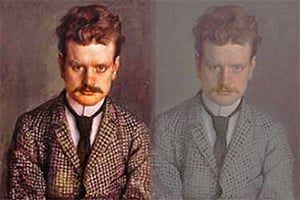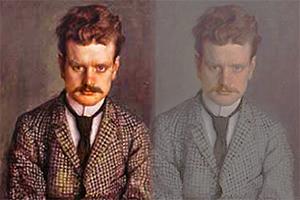
It was a fine program: A premiere, the Sibelius violin concerto, and Edward Elgar’s Enigma Variations. Jennifer Koh, the Sibelius soloist, had technique in spades. The Berkeley Symphony performed very well, with few detectable errors. But lack of drama, questions of balance, and issues of tempo hampered what could have been an outstanding concert.
Koh is an exceptional violinist, technically. But Sibelius is an even more exceptional composer, emotionally. Much of his famous concerto is brooding and agonizing, and full of contrast and passion. That was not conveyed intensely enough for this listener with her fairly clinical rendition at Thursday’s concert. Worse, the few flickers of sunlight in the music were not brought sufficiently to the fore, possibly hindered by Zellerbach Hall’s sound-swallowing rafters that can plague rear-row players. In particular, I was disappointed in barely being able to hear the lovely flute triplets that grace the stern second theme of the finale. Dynamics should be jacked up somewhat in that part of the orchestra to compensate for the hall. But even at the front of the stage, it seemed Koh’s violin was at times without enough force. At least Music Director Joana Carneiro did her best to keep the orchestra down so that Koh would be audible.
An informative profile of British composer Oscar Bettison reveals that he begins his compositions not with a tune, but with a “weird, tenuous, hazy aural image.” Such was the sound of, and the information about Sea Shaped, his Symphony-commissioned work on the program. Bettison’s all-too-brief program note states “I do not intend for this piece to be a depiction of the sea,” yet, in speaking from the stage to the audience, he revealed that he grew up by the sea an that it always meant a lot to him, the way “it was always beginning again.” But Bettison's informing us of his love for the sea and giving us an evocative title cannot be undone by his avowal that “this is not a sea depiction.” It is as self-defeating as telling someone not to think about a horse. Composers who describe their music on stage should prepare as carefully as instrumental soloists on how or whether or not to guide audience imaginations.
As you can probably guess by now, all I could then think about was how Bettison’s 13-minute piece was like the sea. It was a gray, foggy day. The brine rose and fell, the water sluggish with dull brown kelp. Eventually, a foghorn sounded. More swell. End of story. At intermission, patrons gave me their impressions of the music: “Very architectural, like Goldsworthy,” “Difficult,” “A lot of sea,” “Too chaotic,” “Somber,” “More like a zoo than a sea,” “Multilayered,” and, from an Italian, “inquietante” (disquieting).
None mentioned Bettison’s raison d’etre for the music: “I think of Sea Shaped as a kind of ritual. The orchestra is divided into several groups; the strings play a constantly recurring yet evolving figure, whilst other groups interject and disturb this surface.” Ritual doesn’t seem to be the right word. Rituals are established procedures that don’t vary every time they are performed. Perhaps rondo-variations is a better descriptor. Indeed, an introduced string figure is repeatedly varied between short episodes. Variations in dynamics are few. There are occasional inventions of orchestration, but no real sense of drama is achieved at first experience. Will this work receive the multiple performances necessary for listeners to scuba-dive for life amongst the kelp?
After a half-hour intermission, Carneiro set about the Enigma Variations. It’s a great show-off piece for orchestra, for there are many first-chair passages and opportunities for high romanticism and flash, all of which the orchestra proved to be more than capable of executing. Less-than-ideal tempo and balance choices, however, led to a superficial result that did not plumb the depths of the love and friendship Carneiro told the audience the music was about.
The details and stories about Elgar’s friends, lovers, and acquaintances depicted in the music are manifold, not to mention its titular mysteries. What is no mystery to lovers of this, the greatest 19th-century British composition, is that its tempos must be flexible, beyond what is even in the score. With Elgar, rubato, passionate dynamics, and a seemingly precarious sense of control are essential. As the British critic Richard Morrison put it:
This whole business of rubato in Elgar, the way you pull around the tempo, so that the notes seem to ebb and flow in an improvisatory manner — must be a nightmare for conductors. For a start, it’s largely unwritten: it has to be “felt” by the performers.
Not much of that “feeling” was evident in Carneiro’s interpretation. The Theme was too fast. The first variation (Elgar’s wife) was not delicate enough; nor did it gush forth properly at the great show of feeling 10 bars before the end. The fifth variation again was too fast and needed more contrast when suddenly shifting from cheerfulness to morosity. The leap of Elgar’s student’s viola was too subdued in the sixth variation. The famous “Nimrod” variation did not sufficiently bring out the secondary lines (perhaps swallowed by Zellerbach again), and the tempo, though initially effective, needed to ritard more at the end. The most romantic variation of all, number 12, was too fast and bland. Finally, the most enigmatic variation, number 13, though better accomplished than most (especially with the eerily placid Mendelssohn quotation), needed more “pop” on the initial note of the phrase beginning the variation on the clarinet. Thankfully, the final variation proved that the orchestra could reach the fortissimos that were lacking in some of the earlier variations.
I’ve written before about the problems with Zellerbach acoustics. Moving the orchestra forward has helped a great deal, and I now have no trouble hearing the brass properly. But is seems solos in general need to be played more loudly to carry into the audience (I was in row J). The Berkeley Symphony, which is getting better every year under Carneiro’s direction, deserves a decent venue.

